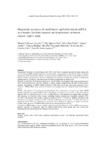Mostrar o rexistro simple do ítem
Diagnostic accuracy of small breast epithelial mucin mRNA as a marker for bone marrow micrometastasis in breast cancer: a pilot study
| dc.contributor.author | Valladares-Ayerbes, Manuel | |
| dc.contributor.author | Iglesias-Díaz, Pilar | |
| dc.contributor.author | Díaz-Prado, Silvia | |
| dc.contributor.author | Ayude, Daniel | |
| dc.contributor.author | Medina Villaamil, Vanessa | |
| dc.contributor.author | Haz, Mar | |
| dc.contributor.author | Reboredo, Margarita | |
| dc.contributor.author | Antolín, Silvia | |
| dc.contributor.author | Calvo, Lourdes | |
| dc.contributor.author | Antón-Aparicio, Luis M. | |
| dc.date.accessioned | 2018-05-09T09:49:52Z | |
| dc.date.available | 2018-05-09T09:49:52Z | |
| dc.date.issued | 2009-02-17 | |
| dc.identifier.citation | Valladares-Ayerbes M, Iglesias-Díaz P, Díaz-Prado S, Ayude D, Medina V, Haz M, et al. Diagnostic accuracy of small breast epithelial mucin mRNA as a marker for bone marrow micrometastasis in breast cancer: a pilot study. J Cancer Res Clin Oncol. 2009:135(9):1185-1195. | es_ES |
| dc.identifier.issn | 0171-5216 | |
| dc.identifier.issn | 1432-1335 | |
| dc.identifier.uri | http://hdl.handle.net/2183/20696 | |
| dc.description.abstract | [Abstract] Background. Detection of isolated tumour cells (ITC) in the blood or minimal deposits in distant organs such as bone marrow (BM) could be important to identify breast cancer patients at high risk of relapse or disease progression. PCR amplification of tissue or tumour selective mRNA is the most powerful analytical tool for detection of this micrometastasis. We have evaluated for the first time, the diagnostic accuracy of small breast epithelial mucin (SBEM) as a potential marker for BM micrometastasis in breast cancer. Methods. A nested RT-PCR assay for detection of SBEM mRNA was compared with immunocytochemistry (ICC) with anticytokeratin AE1/AE3 antibody in paired samples obtained from the BM of breast cancer patients. Associations of SBEM mRNA detection in BM and clinical and pathological parameters were evaluated. SBEM mRNA status and time to breast cancer progression were analysed using Kaplan–Meyer curves. Results. Fifty stages I–IV breast cancer female patients were prospectively included in our study. SBEM specific transcript was found in BM in 26% of the patients. Detection rate was similar to the percentage of patients with ITCs detected using ICC (24%). SBEM mRNA in BM aspirates were significantly associated with presence of clinically active disease, including locally advanced and metastatic patients (47%, P = 0.021) and tumours with positive hormonal receptors (36.7%, P = 0.035). In addition association with Her2/neu over-expression (44.4%, P = 0.051) and low proliferating tumours (36%, P = 0.067) were close to significant levels. When we analysed time to breast cancer progression adjusting for grade or hormone receptor status, presence of SBEM mRNA in BM defines distinct prognostic groups. Conclusions. SBEM might represent a suitable marker for molecular detection of ITCs in BM in breast cancer patients. Analysis of prognostic value for SBEM mRNA-based assay should take into account the heterogeneity and different molecular subtypes of breast cancer. | es_ES |
| dc.description.sponsorship | This study was supported by grant 2000-5435256011 from Universidade da Coruña. S. Díaz-Prado is supported by an Isidro Parga Pondal research contract by Xunta de Galicia. | es_ES |
| dc.language.iso | eng | es_ES |
| dc.publisher | Springer-Verlag | es_ES |
| dc.relation.uri | https://doi.org/10.1007/s00432-009-0559-7 | es_ES |
| dc.rights | The final publication is avaliable at Springer Link | es_ES |
| dc.subject | Isolated tumour cells | es_ES |
| dc.subject | Small breast epithelial mucin | es_ES |
| dc.subject | Breast tumour cells | es_ES |
| dc.subject | Minimal disease | es_ES |
| dc.subject | RNA-based methods | es_ES |
| dc.title | Diagnostic accuracy of small breast epithelial mucin mRNA as a marker for bone marrow micrometastasis in breast cancer: a pilot study | es_ES |
| dc.type | info:eu-repo/semantics/article | es_ES |
| dc.rights.access | info:eu-repo/semantics/openAccess | es_ES |
| UDC.journalTitle | Journal of Cancer Research and Clinical Oncology | es_ES |
| UDC.volume | 135 | es_ES |
| UDC.issue | 9 | es_ES |
| UDC.startPage | 1185 | es_ES |
| UDC.endPage | 1195 | es_ES |
Ficheiros no ítem
Este ítem aparece na(s) seguinte(s) colección(s)
-
GI-FENM - Artigos [119]
-
INIBIC-TCMR - Artigos [102]






